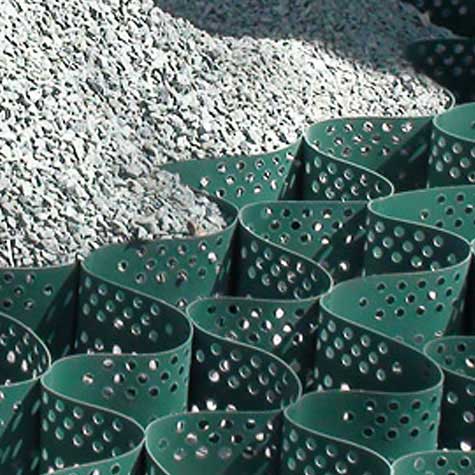Features:
1. It is flexible in expansion and contraction, and can be folded during transportation. It can be stretched into a net during construction, and filled with loose materials such as soil, gravel, concrete, etc., to form a structure with strong lateral restriction and large rigidity.
2. Light material, abrasion resistance, stable chemical performance, resistance to photooxidation, acid and alkali resistance, suitable for different soils and deserts and other soil conditions.
3. High lateral restriction and anti-slip, anti-deformation, effectively enhance the bearing capacity of the roadbed and disperse the load.
4. Changing the geometric dimensions of geocell height, welding distance, etc. can meet different engineering needs.
5. Flexible expansion, small transportation volume, convenient connection and fast construction speed. That is to say, once the load acts on the subgrade, an active area with a taper shape will be formed under the load, which is squeezed through the transition area, so that the passive area will bulge. In other words, the bearing capacity of the foundation is determined by the shear force along the slip line and the force in the active, transitional and passive regions of movement. Not only can you clearly experience the true process of the above principles on sandy bases, but you will also find such a model on soft roads, but the rate of formation is slower than the change on sand. Even better roadbed materials still cannot avoid their lateral movement. The roadbed of general highways is several meters above the ground. It is not easy to absorb water and muddy, but long-term settlement still exists. Investigating the reasons, rainwater penetration, material loss, and base sinking are some of the reasons. Under the action of long-term rolling and vibration of the wheel load, the lateral displacement of the material to both sides of the subgrade section is undeniably another very important reason. . Take the highways at all levels in our province as an example, there is an "S"-shaped groove belt on the main carriageway of the road that can be clearly felt. Some expressways are no exception. The bumps of a car driving on the road are obviously stronger than the feeling of driving on an overtaking belt, especially at the road-bridge junction (commonly known as "bridge-head jumping"). This trench roadbed settlement is typical of the lateral slippage of roadbed materials.
There is no need to repeat the conventional methods of subgrade treatment in the project. Its purpose is to improve the shear resistance and friction of the foundation material, and reduce or delay the ability of the foundation material to move under the pressure or vibration of the load. Therefore, the requirements for the material in the project are inevitable. There are many strict restrictions. If you cannot obtain the required materials nearby, you need to purchase these materials outsourcing. The cost of purchasing materials and transportation costs account for a large part of the entire project cost. Using geocells, materials can be obtained locally or nearby, and even materials that cannot be used under normal circumstances can be used, thereby greatly reducing material purchase costs and transportation costs. Why does this happen? The load-bearing situation of the geocell: under the action of concentrated load, the active zone 1 will still transmit the force to the transition zone 2, but due to the lateral restriction of the cell wall and adjacent cells The reaction force of the chamber and the lateral resistance formed by the friction between the filler and the cell wall inhibit the lateral movement tendency of the transition zone 2 and the passive zone 3, thereby improving the bearing capacity of the roadbed. Through experiments, the apparent cohesion of medium-density sand can be increased by more than 30 times under the restriction of the cell. Obviously, if the shear resistance of the subgrade material can be increased or the movement of the three areas can be suppressed, the effect of improving the bearing capacity of the foundation can be achieved. This is the limiting principle of the geocell. As a new type of synthetic material, geocells have started a lot of research and development work in the late 1980s and early 1990s in Europe, America and other countries. Tests and field applications have proved that they can improve the general fill withstand dynamic loads and roadbed protection. All aspects have great effects. On the basis of absorbing advanced foreign experience in the early 1990s, my country began the development and research of geocells, and made major breakthroughs in the treatment of road bed diseases and the application of fixed loose media. With the further understanding of the characteristics of geocells, it has been found that it has the irreplaceable advantages of other geotextiles (geotextiles, geomembranes, geogrids, geotextile bags, geonets, etc.), making it unique in many fields Application prospects.
